Gear
Grizzly Bass from Creation Audio Labs Roars on Many Levels
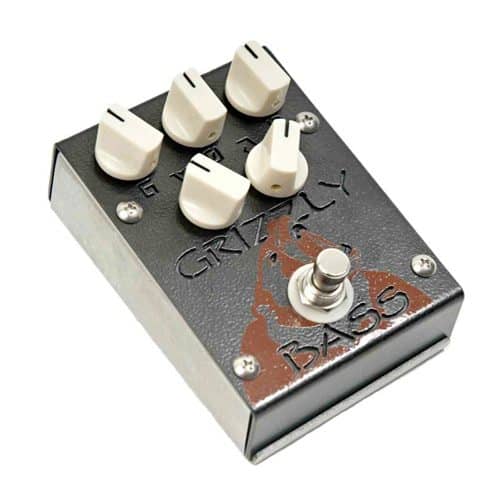
 In the sea of overdrive, distortion and fuzz pedals, it’s hard to find the one that will fit your needs. The large bulk of them look the same, have the same layout and sound fairly similar as well. And when you try to layer more than one of these effects together, you usually wind up with a lot of sonic mush. Enter the Grizzly Bass from Creation Audio Labs, the pedal that is going to make you rethink how a pedal can work, and also how different sounds can work together.
In the sea of overdrive, distortion and fuzz pedals, it’s hard to find the one that will fit your needs. The large bulk of them look the same, have the same layout and sound fairly similar as well. And when you try to layer more than one of these effects together, you usually wind up with a lot of sonic mush. Enter the Grizzly Bass from Creation Audio Labs, the pedal that is going to make you rethink how a pedal can work, and also how different sounds can work together.
Based off the success of previous pedals Holy Fire, MW1 and the Funkulator, the Grizzly Bass gives tube-amp simulation without the weight and fragility of tube amps. Immediately, the pedal itself demands attention; it almost completely lights up when you plug in the power supply! The teeth of the Grizzly light up to show the effect is ON, which is a nice touch. The layout of the knobs is very well laid out; top row (l to r) is gain, overdrive, distortion with the bottom row (l to r) at mid sweep and hi-cut filter. It initially took me a little bit to learn how each of these knobs reacted; the usual “Gain, Treble, Bass, Grit” style of control was gone. However, once I started turning knobs, it was apparent how much more intuitive this type of layout is, but also how versatile.
For example, the GAIN control on the Grizzly is the master volume; you can have all the other knobs turned completely off and use just the Grizzly as a boost pedal. Or, if you add in the MID SWEEP, you essentially have Creation Audio’s Funkulator pedal at your disposal. Toss in the HI-CUT FILTER to start making your hi-fi sound a little more analog. Or, if you’re already rocking a passive bass, use it to emulate the tube sounds you might enjoy from that extremely heavy amp that sits in your rehearsal space.
But, once you start playing with the OVERDRIVE and DISTORTION circuits, you really see where the Grizzly starts to roar. The typical distortion pedals use gain and clipping to achieve the desired effect, which usually ends up with a lot of noise that in the filtering process, thins out the tone. Ever try to play a bass through a guitar pedal and wonder where all your tone went? That’s what’s happening. The Grizzly approaches it in a different way; shaping the waveform in order to achieve the same sonic results, but retaining your tone in the process (as the website says, “all the way down to 20Hz”).
With this different approach to creating overdrive and distortion, how does it really affect your tone? It makes it extremely musical. Every nuance in your attack, whether you’re a finger or pick player, will translate into the Grizzly. Play a little lighter to lessen the grit and dig in for the chorus to hear some more. Listen to the huge wash of overdriven distortion ebb and flow to your every phrase. The Grizzly is going to easily become one of those pedals that you end up “playing,” to capitalize on the abilities that it has.
So, in a sea of similar effect pedals, where does the Grizzly Bass from Creation Audio Labs wind up? It’s not strictly an overdrive pedal, a distortion pedal, a boost, a mid scoop or even a hi-cut filter. Sure, you can use just one of those effects if you want, and you’ll be very happy. But the combination of more than one is what sets the Grizzly apart from everything else in the market. The ingenuity of the folks at Creation Audio have brought forth a new way of thinking how a distortion type pedal should look, act, and most important, react to the musician. The end result is something that many people are going to be using to replace multiple pedals on their board.
Grizzly Bass from Creation Audio Labs
Direct Price – $195 (introductory offer; jump on it!)
Bass Videos
Gear News: Spector Launches Euro CST and Euro LX Basses
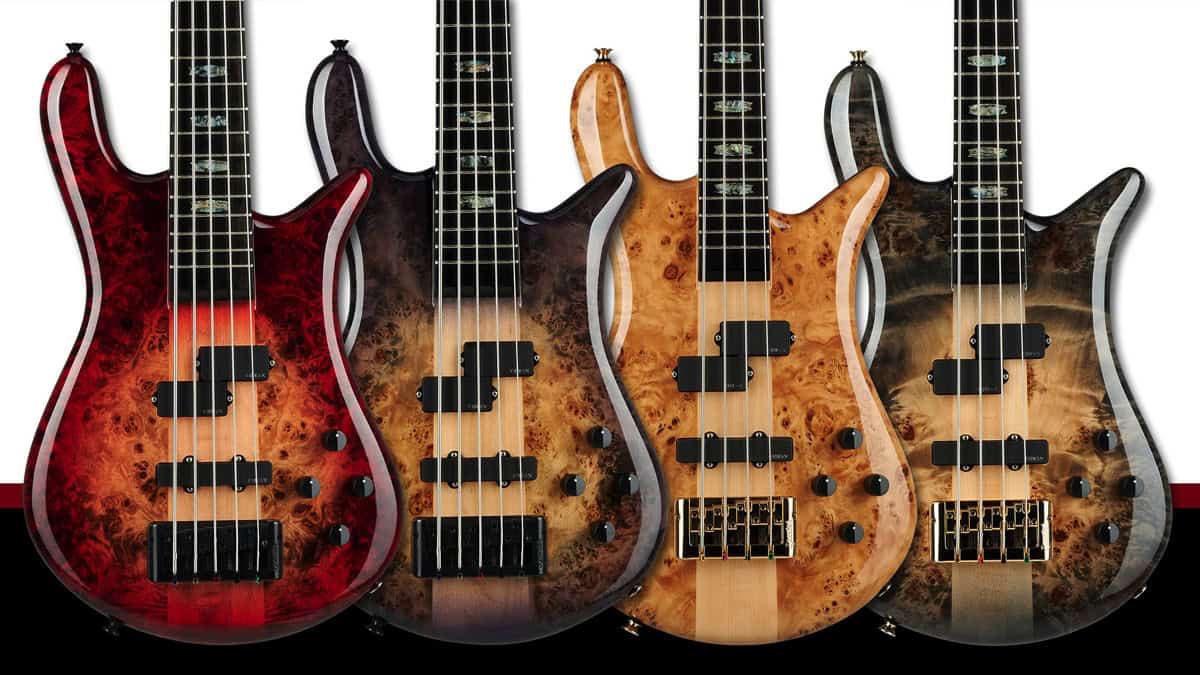
Spector, a leading authority in bass guitar design, unveils new additions to its product line: Euro CST, Euro LX and Euro LX Bolt On basses.
Euro CST:
The Euro CST introduces all-new tonewoods, electronics, and finish combinations never seen in the Euro Series, drawing inspiration from Spector’s Woodstock, NY-based Custom Shop. Each Euro CST instrument is meticulously crafted using premium materials, featuring a striking, highly figured Poplar Burl top, a resonant European Ash body, and a 3-piece North American Maple neck paired with an Ebony fingerboard adorned with laminated Abalone Crown inlays.
Euro CST basses are equipped with a lightweight aluminum bridge for precise and reliable intonation. Premium active EMG X Series pickups deliver the exceptional clarity, attack, and silent operation that defines the Spector sound. These basses also feature the all-new Spector Legacy preamp. Developed in collaboration with Darkglass Electronics, this preamp captures the classic “Spector growl,” heard on countless iconic recordings, with added versatility.
Euro CST basses are available in 4- and 5-string models in four distinct high gloss finishes: Natural, Natural Black Burst, Natural Red Burst, and Natural Violet Burst.
Euro LX and Euro LX Bolt-On:
The Euro LX offers all the features that have made the Spector name famous around the globe. Inspired by the iconic NS-2, Euro LX basses feature a fully carved and contoured body, high-grade tonewoods, and professional-grade electronics and hardware. For the first time ever, players can now choose between neck-thru and bolt-on construction in the Euro LX range.
Each Euro LX bass, regardless of construction, is crafted using premium materials, including a European Alder body, figured European Maple top, and a 3-piece North American Maple neck combined with a Rosewood fingerboard for strength, stability, and sustain. Euro LX basses are then outfitted with a lightweight, aluminum bridge for spot-on, reliable intonation. Premium active pickups from EMG provide the exceptional clarity, attack, and silent operation that Spector is known for. Like the Euro CST basses, these instruments also feature the all-new Spector Legacy preamp.
The newly revised Euro LX range is available in four distinct, hand-rubbed stains, including Transparent Black, Natural Sunburst, Haunted Moss, and Nightshade. Each of these colors features a durable and comfortable matte finish.
John Stippell, Director, Korg Bass Division, remarks, “I’m thrilled to announce the latest additions to the renowned Euro Range. The CST Series, our new premium offering, features new and unique wood combinations and unprecedented features. The beloved LX Series is now better than ever with the introduction of Bolt-On models, vibrant new color options, and the all-new Spector Legacy Preamp, delivering the classic Spector tone with unmatched precision.”
For more information, visit spectorbass.com.
Latest
Luthier Spotlight: Garry Beers, GGB Basses
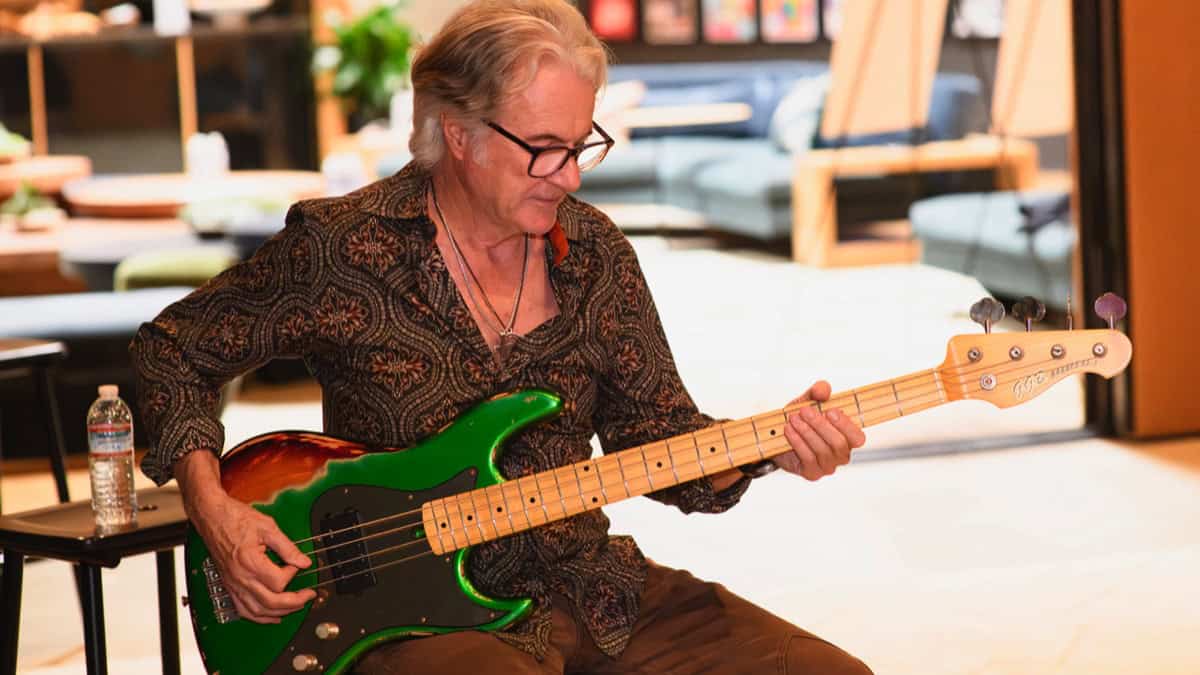
Meet Garry Beers, Luthier and owner of GGB Basses…

Bass Musician Magazine: How did you get your start in music?
Garry Beers: I played acoustic guitar as a kid with my mates at school. We decided that one of us should play bass, so we had a contest where the one who knew the least guitar chords would buy a bass – so I lost the contest, bought my first bass, and became the only bass player in the neighborhood. Soon after, I met Andrew Farriss, who had heard that I had a bass, and a few days later, I was jamming with Andrew and Jon Farriss.
Are you still an active player?
Yes, I am still actively writing music and playing bass sessions. I also have an LA-based original band called Ashenmoon.
How did you get started as a Luthier? When did you build your first bass?
I did woodwork in High School and always enjoyed making all sorts of things out of wood.
After finishing high school, I took a course in electronics for a year or so and learned enough to understand basic circuits in guitars, amplifiers, and effects. The best way to learn is to deconstruct and study, so my dad’s garage was littered with old junked radios and any instrument parts I could find.
My first guitars were more like Frankenstein-type creations made out of parts I found here and there. I didn’t really try to build a bass from scratch until I perfected my Quad pickup design and got my patent.
How do you select the woods you choose to build with?
I only use woods that were used at Fender in the 50s, which are my favorite basses and guitars of all time. All my GGB basses are modeled in some way from my INXS bass- a 1958 Fender Precision bass I bought in 1985 in Chicago. I call her “Old Faithful,” and she has an Alder wood body with a maple neck. All of my GGB basses are select Alder wood bodies that I have had extra dried, so they match the resonance of “Old Faithful,” as she has had 66 years to lose all her moisture and become more resonant and alive-sounding. I use plain old Maple necks that I carefully select, and again, I dry the necks to make them sing a little more.
Tell us about your pickups.
I started working on my Quad coil design back in Australia in the ‘90s and then put it to bed, so to speak, until I found an old pickup winding machine at a swap meet here in LA. I taught myself enough about pickup winding to build my first prototype design and worked towards my patented Quad coil design by trial and error. Nordstrand Audio builds the pickups for me here in SOCAL.
What is the reaction of players who pick up your basses?
I build the basses to feel like an old friend. They look and feel vintage, and when you plug them in, you discover the array of vintage sounds available to you from just one pickup. Most of the players I have contact with are established professional players, and they all love the basses. Freddie Washington and Nick Seymour from Crowded House are a couple of players with GGB Basses in their hands.
What are a few things that you are proud of in your instruments and would consider unique?
I would say I am most proud of the patented Quad pickup design. I own the patent from 4 through to 10-string. So far, I have only built 4 and 5-string pickups, but the design is a winner. Split Humbucker / Reverse Split Humbucker / Full Humbucker / Single coil Neck / Single coil bridge. All these sounds come from one passive pickup. I am very proud that my perseverance and desire to have this pickup have made it a reality. Being able to have these sounds in one bass enables the player to have one bass in the studio and on the stage. The only place you can have the GGB Quad pickup is in one of my GGB Basses.
Which one of the basses that you build is your favorite one?
I offer three body shapes and about ten different color options – all based on the ‘50s and early ‘60s custom guitar and car paint styles. I have always been a lover of P basses, but my favorite bass I build is now my XS-1 model- which is a custom Jazz bass body style. It is pretty sexy and is a light, well-balanced, and great-feeling body shape. The other body styles are the XS-2, which is a custom Jazzmaster body and has been the most popular so far- and the XS-3, which is the standard P bass body style. I also offer an XS-58, which is a replica of my “Old Faithful” ‘58 P bass. They are currently available to order now and should be available soon.
Can you give us a word of advice to young Luthiers who are just starting out?
I don’t really consider myself a Luthier in the traditional sense. I just love to build things and tinker. I was always looking to improve things, whether it was a guitar, an amp, a pedal board, or a car. So my advice is to always be curious and learn the basics of what you want to build, and the rest should follow once you decide what you want to say as a designer/builder. People are lucky these days that you can learn pretty much anything from talented people on the internet, but nothing replaces working with and learning from real people in real situations. Seek out like-minded builders and start a discussion.
What advice would you give a young musician trying to find his perfect bass?
Have a good hard think about what you want to say as a player. What is your style, both musically and as a player? There are so many instruments available. Do the research, play the instruments that fit your criteria, and make a decision. But make sure you try a GGB Bass! With all the sound choices my basses offer, with a simple turn of a knob, you may find it easier to find “your” sound.
What is the biggest success for you and for your company?
Well, the company is brand new, and at this point, it is just me, so getting this far in the manufacturing process and now having these amazing basses in my hands is a great achievement, but now comes all the business stuff!!
What are your future plans?
It’s a work in progress. Right now, it’s all about getting the word out and getting the basses into the hands of interested players. I believe in the basses – and the Quad pickup, so hopefully, GGB Basses can become a go-to bass for demanding studio and live players who want sound choices in a gorgeous vintage-style instrument.
Visit online at www.ggbbasses.com
Gear Reviews
Gear Review: Joyo Monomyth – A Versatile Modern Bass Preamp
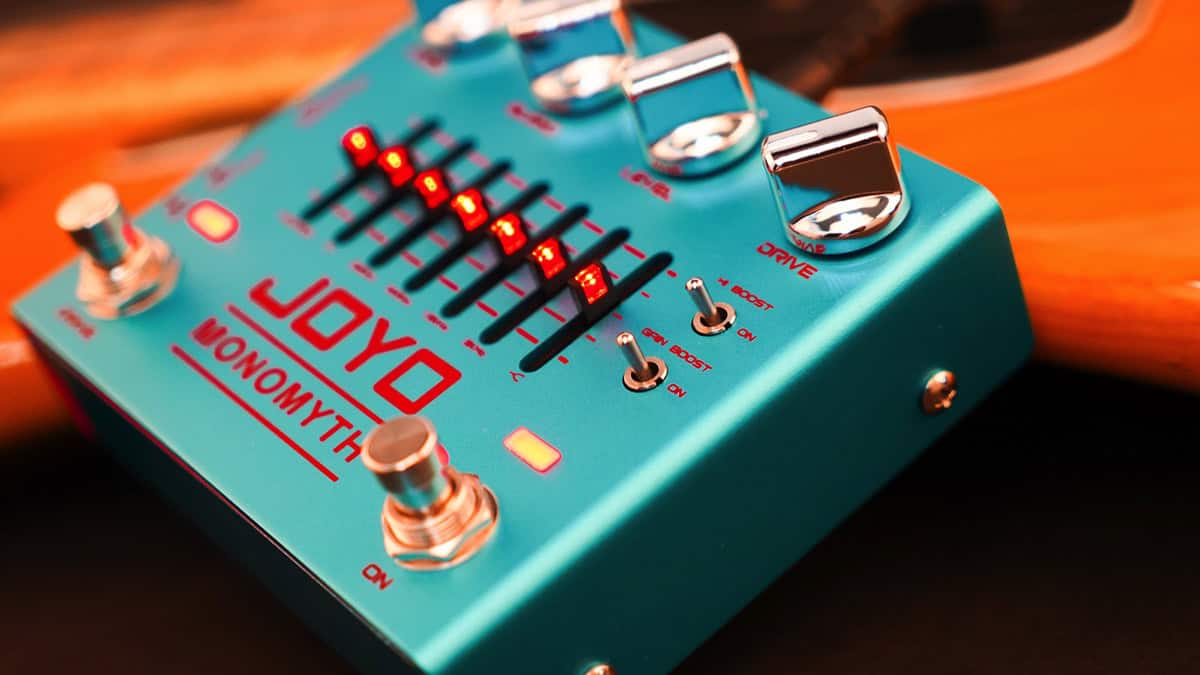
Disclaimer: This pedal was kindly provided by Joyo for the purpose of this review. However, this does not influence our opinions or the content of our reviews. We strive to provide honest, unbiased, and accurate assessments to ensure that our readers receive truthful and helpful information.
Introduction:
The Joyo Monomyth bass preamp pedal is designed to offer bassists a comprehensive range of tonal options, combining modern features with practical functionality. With independent channels for EQ and overdrive, as well as useful additions like a cab sim and DI output, the Monomyth aims to be a versatile tool for both live performances and studio sessions. This review will delve into the pedal’s specifications, controls, and overall performance to determine if it lives up to its promise of delivering quality and flexibility at an affordable price.
Specifications:
– Dimensions: 130 * 110 * 50 mm
– Weight: 442g
– Working Voltage: DC 9V
Controls:
The Joyo Monomyth is equipped with a comprehensive set of controls designed to provide maximum tonal flexibility:
– Voice: Adjusts the character of the overdrive, from distortion to fuzz.
– Blend: Balances the dry and effected signals, crucial for maintaining low-end presence.
– Level: Sets the overall output volume.
– Drive: Controls the amount of gain in the overdrive channel.
– Treble Boost: Enhances high and mid frequencies for clarity in complex passages.
– Gain Boost: Adds extra gain, particularly effective at low gain settings to enhance the low e.
– EQ Function Controls: Features a 6-band graphic EQ plus a master control for precise nal shaping.
– Ground Lift Switch: Helps eliminate ground loop noise.
– Cab Sim Switch: Activates a simulated 8×10″ cab sound.
– LED Light Control: Customizes the pedal’s ambient lighting.
Performance:
The Joyo Monomyth shines in its dual-channel design, offering both a transparent EQ channel and a versatile overdrive channel. The 6-band EQ allows for detailed tonal adjustments, preserving the natural character of your bass while providing ample flexibility. The voice control mimics the functionality of the Darkglass Alpha Omega, shifting from distortion to fuzz, with a sweet spot around the middle for balanced tones.
The blend control is essential for retaining the low end when using distortion, ensuring your bass remains powerful and clear. The treble and gain boosts, available on the overdrive channel, further enhance the pedal’s versatility, making it suitable for everything from subtle drive to full-blown fuzz.
Outputs are plentiful, with a DI and XLR out for direct recording or ampless setups, and a headphone out for convenient practice sessions. The cab sim switch adds a realistic 8×10″ cab sound, enhancing the Monomyth’s utility in live and studio environments.
Pros:
– Versatile Control Set: Offers a wide range of tones, from clean to fuzz.
– Blend Control: Maintains low-end presence.
– Robust Outputs: DI, XLR, and headphone outs make it adaptable for various setups.
– Affordable: Provides high-end functionality at a budget-friendly price.
– Sturdy Construction: Durable build quality ensures reliability.
Cons:
– Plastic Knobs: May feel less premium compared to metal controls.
– Boosts Limited to Overdrive Channel: Treble and gain boosts do not affect the EQ channel.
– Cab Sim only on the XLR out: how cool would it be to also have it on the headphone out?
Conclusion:
In conclusion, the Joyo Monomyth stands out as a versatile and powerful bass preamp pedal, offering a range of features that cater to both traditional and modern bassists. Its dual-channel design, comprehensive control set, and robust output options make it a valuable tool for achieving a wide spectrum of tones, from clean and warm to heavily distorted. For bassists seeking flexibility, reliability, and excellent value, the Joyo Monomyth is a top contender.
For more information, visit online at joyoaudio.com/product/267.html
Bass Videos
Gear News: Future Impact V4 Guitar & Bass Synth Now Available in the U.S.
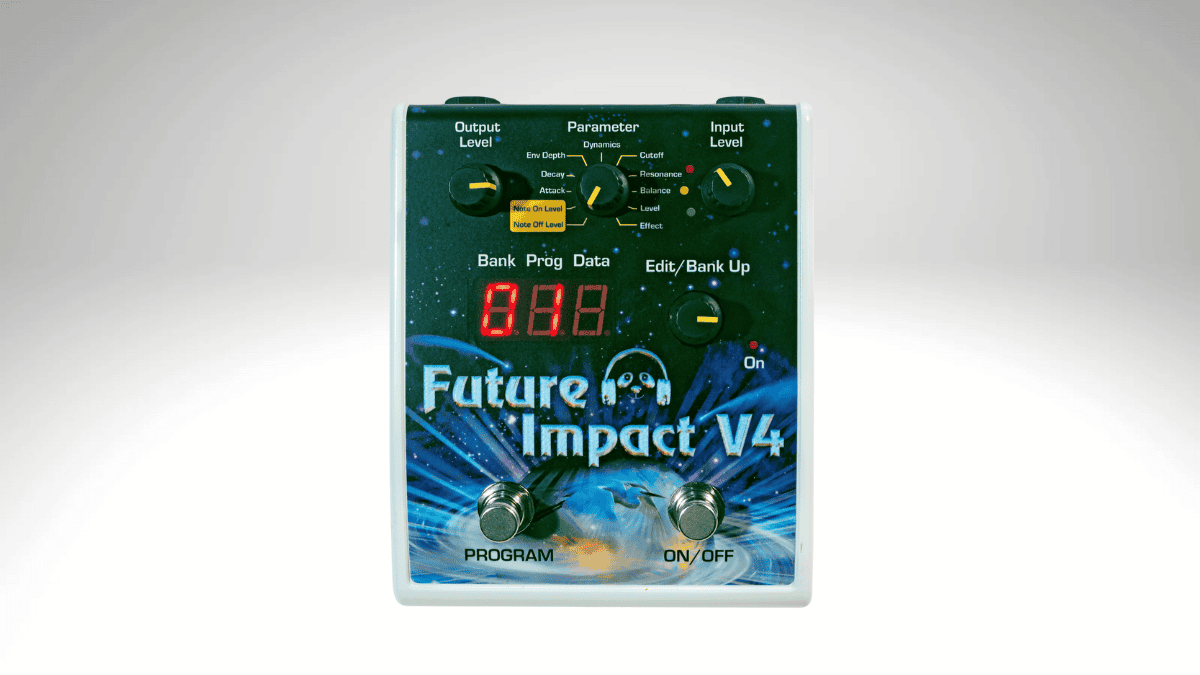
Future Impact V4 Guitar & Bass Synth Now Available in the U.S….
The Future Impact V4 is an incredibly versatile pedal with an exceptionally wide range of sounds. In addition to producing synthesizer sounds such as basses, leads and pads, it can function as an octaver, chorus, flanger, phaser, distortion, envelope filter, traditional wah-wah, tremolo, reverb, etc., and even has a built-in tuner. It can also drive external synthesizer gear via the optional CV/Gate. As such, it can potentially replace an entire pedalboard of dedicated single-effect pedals.
The very powerful signal processor of the Future Impact V4 is able to replicate the various oscillator, filter, amplifier and envelope generator blocks found in classic synthesizers. In addition, it contains signal processing blocks more traditionally used for processing the sound of an instrument such as a harmonizer block and audio effects such as chorus, distortion and EQ. These architectures complement each other in a very flexible way.
Check out this short video with new sounds:
The Future Impact V4 has a completely new hardware platform with numerous enhancements, some of which are:
– 32-bit ultra-low-noise analog-to-digital and digital-to-analog converters
– New app-based software architecture
– Vastly advanced pitch tracking based on 30+ years of experience
– Hard Sync between oscillators to open new sonic worlds
– On-pedal edits that can be saved into program memories
– Total compatibility with all previous Deep Impact and Future Impact patches
Setting the standard for the bass guitar synth pedals since 2015, together with an enthusiastic community and long line of great artists, the Future Impact V4 is the guitar synth platform for the next decade.
For more information, visit online at pandamidi.com/bass-guitar-synth
Exclusive U.S. distribution by Tech 21 USA, Inc
Gear Reviews
Gear Review: Joyo Double Thruster – Modern Bass Distortion Redefined
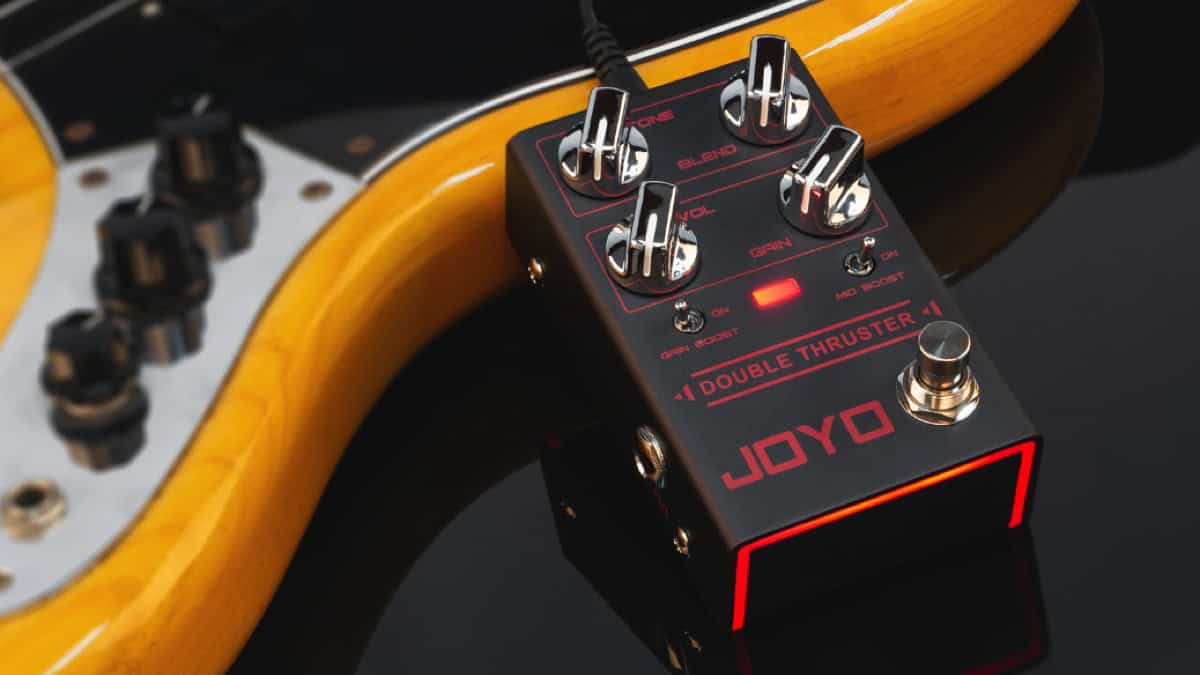
Review of the Joyo Double Thruster…
Disclaimer: This pedal was kindly provided by Joyo for the purpose of this review. However, this does not influence our opinions or the content of our reviews. We strive to provide honest, unbiased, and accurate assessments to ensure that our readers receive truthful and helpful information.
Introduction: When it comes to bass distortion, finding a pedal that delivers a wide spectrum of tones while maintaining the essential low end can be challenging. The Joyo Double Thruster, a modern bass distortion pedal designed to cater to the diverse needs of bassists was a pleasant surprise that we had the opportunity to review. From subtle overdrive to full-on fuzz, the Double Thruster delivers with versatility and affordability.
Specs: The Joyo Double Thruster is compact yet robust, making it ideal for both stage and studio use. Here are its key specifications:
Dimensions: 109 * 72 * 48 mm
Weight: 250g
Working Voltage: DC 9V
Controls: The Double Thruster features a comprehensive control set that allows for precise tonal sculpting:
Tone: Adjusts the overall tonal character of the distortion.
Blend: Critical for bassists, this control blends the dry signal with the distorted signal, ensuring the low end remains intact.
Volume: Sets the output level of the pedal.
Gain: Controls the amount of distortion, from mild overdrive to full fuzz.
Gain Boost Switch: Provides a noticeable boost, especially at lower gain settings, enhancing the low end and adding depth to the tone.
Mid Boost Switch: Boosts mid frequencies, helping the sound cut through the mix with greater clarity and definition.
LED Light Control: Customizes the ambient lighting of the pedal.
Performance: The Joyo Double Thruster excels in delivering a range of distortion tones while retaining the essential low end that bassists need. The blend control is particularly useful, allowing users to mix the clean and distorted signals to maintain clarity and punch. The gain boost switch adds a pleasing depth to the low end, especially noticeable at lower gain settings, while also compensating for low end loss at higher gain levels. The mid-boost switch enhances the pedal’s ability to cut through complex mixes, making it ideal for intricate playing.
In terms of versatility, the Double Thruster can emulate a variety of distortion sounds, from subtle warmth to high-mid, djenty grind. This makes it an excellent tool for bassists exploring different genres and styles.
Pros:
- Blend Control: Essential for retaining the low end in a distorted signal.
- Size and Weight: Compact and sturdy design.
- Rugged Construction: Durable build quality.
- Gain and Mid Boosts: Adds versatility and clarity to the tone.
- Affordable Price: Offers excellent value for money.
Cons:
- Plastic Knobs: May feel less premium compared to metal controls.
- Comparison to High-End Pedals: While close, it may not fully match the tone of more expensive pedals like the Darkglass B3K, and that’s ok. The Double Thruster is a great pedal on its own!
Conclusion: In conclusion, the Joyo Double Thruster stands out as a versatile and affordable option for bassists seeking a wide range of distortion tones. Its thoughtful design and comprehensive controls make it a great tool for achieving everything from mild overdrive to full fuzz, all while maintaining the crucial low end. For bassists looking to expand their tonal palette without breaking the bank, the Joyo Double Thruster is a must-have addition to their pedalboard.
Visit online at joyoaudio.com





















